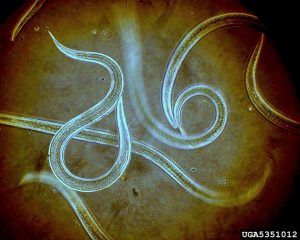Bulletin #7144, Approaches to the Biological Control of Insects
Bulletin #7144, Approaches to the Biological Control of Insects (PDF)
Kimberly Stoner, PhD, Vegetable Entomologist, Connecticut Agricultural Experiment Station.
For information about UMaine Extension programs and resources, visit extension.umaine.edu.
Find more of our publications and books at extension.umaine.edu/publications/.
Table of Contents
- Natural Enemies of Pest Insects
- Using Biological Control in the Field
- Conservation of Existing Natural Enemies
- Introducing New Natural Enemies and Establishing a Permanent Population
- Mass Culture and Periodic Release of Natural Enemies
- Relationship of Biological Control to Sustainable Agriculture
- Sources of More Information
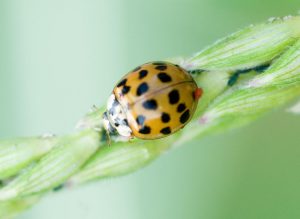
Biological control is the use of living organisms to suppress pest populations, making them less damaging than they would otherwise be. Biological control can be used against all types of pests, including vertebrates, plant pathogens and weeds as well as insects. The methods and agents used are different for each type of pest. This fact sheet focuses on the biological control of insects and related organisms.
Natural Enemies of Pest Insects
“Pests” are species that attack some resource we want to protect, and do it well enough that they cause losses or are a major annoyance. Pests are only a tiny fraction of the insect species around us. Many pest species only occasionally do real damage.
Natural enemies play an important role in limiting potential pest populations. We have seen what happens when pesticides devastate the natural enemies of potential pests. Insects that were of little economic importance can become damaging pests. When a non-toxic control method is used, natural enemies are more likely to survive and reduce the numbers and damage of potential pest species.
There are three categories of natural enemies of insect pests:
- predators;
- parasitoids; and
- pathogens.
Predators. Many kinds of predators feed on insects. Insects are an important food for many vertebrates, including birds, amphibians, reptiles, fish and mammals. These “insectivorous” vertebrates usually feed on many insect species, and rarely focus on specific pests, unless they are very abundant. Insect and related predators are more often used in biological control because they feed on a smaller range of prey species. These predators, with their shorter life cycles, may also fluctuate in population density in response to changes in the density of their prey. Important insect predators include lady beetles, ground beetles, rove beetles, flower bugs and other predatory true bugs, lacewings and hover flies. Spiders and some families of mites are also predators of insects and mite pests.
Parasitoids. Parasitoids are insects with an immature stage that develops on or in an insect host, and ultimately kills the host. Adults are typically free-living, and may be predators. They may also feed on other resources, such as honeydew, plant nectar or pollen. Because parasitoids must be adapted to the life cycle, physiology and defenses of their hosts, many are limited to one or a few closely related host species. Thus, accurate identification of the host and parasitoid species is very important if you use parasitoids for biological control.
Pathogens. Insects, like other animals and plants, are infected by bacteria, fungi, protozoans and viruses that cause disease. These diseases may reduce the rate of feeding and growth of insect pests, slow or prevent their reproduction, or kill them. In addition, insects are also attacked by some nematodes that, along with the bacteria they carry, cause disease or death. Under certain conditions, diseases can multiply and spread naturally through an insect population, particularly when the density of the insects is high.
An example of an insect pathogen that has been successfully controlling its host is the fungus Entomophaga maimaiga, a pathogen of the gypsy moth. This fungus was introduced about 1911, but was not recovered in forests until 1989, when it was widespread and abundant in New England. It has continued to control New England gypsy moth populations for several years. It overwinters in leaf litter as resting spores, which germinate when gypsy moth larvae are present. Newly hatched caterpillars are dispersed by wind, and those that fall to the forest floor are probably infected while crawling to a tree. While these larvae are feeding in the tree canopy, if there is enough rainfall, the fungus in their bodies produces spores that spread to other caterpillars. If conditions are right, this infection cycle occurs again during the larval stage. Large caterpillars rest during the day in forest litter, where they are also susceptible to infection. In late June, as infected caterpillars die in large numbers, new resting spores are produced to survive the next winter. This biological control process depends on well-timed rainfall to be successful.
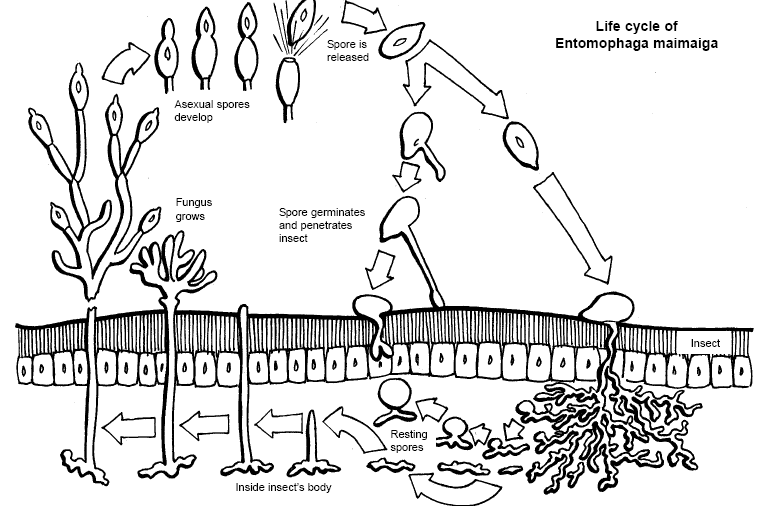
Using Biological Control in the Field
There are three primary methods of biological control:
- conservation of existing natural enemies;
- introducing new natural enemies and establishing a permanent population (called “classical biological control”); and
- mass rearing and periodic release, either as a seasonal introduction of a small population of natural enemies, or a massive, “inundative” release.
Conservation of Existing Natural Enemies
Reducing pesticide use: Most natural enemies are highly susceptible to pesticides, so pesticides limit their effectiveness. The first step in reducing pesticide use is to develop economic thresholds and methods to monitor populations to see if they exceed thresholds. The need for pesticides can also be reduced by increasing the pest resistance of crop plants and animals, disrupting pest mating or host-finding behavior, and using cultural and physical methods to reduce pest numbers or their damage. As you use fewer pesticides, you may increase the effectiveness of existing natural enemies against multiple pests. So the benefit to the farmer may be much more than just saving the cost of the chemical and its application.
Selecting and using pesticides to minimize the effect on natural enemies: The effect of a pesticide on natural enemy populations depends on the physiological effect of the chemical and on how the pesticide is used — how and when it is applied, for example. While insecticides and acaricides (pesticides that kill mites and ticks) are most likely to be toxic to insect and mite natural enemies, herbicides and fungicides are sometimes toxic as well. A database has been compiled on the effects of pesticides on beneficial insects, spiders and mites (summarized in Croft 1990 and Benbrook 1996). This database compares the toxicity of different pesticides and the “selectivity ratio” — the dose required to kill 50 percent of the target pest divided by the dose that kills 50 percent of the affected natural enemy species. Among insecticides, synthetic pyrethroids are among the most toxic to beneficials, while Bacillus thuringiensis and insect growth regulators were among the least toxic. In general, systemic insecticides, which require consuming plant material for exposure, and insecticides that must be ingested for toxicity affect natural enemies much less than pests.
Pesticides may also have more subtle effects on the physiology of natural enemies than direct toxicity. Several fungicides, such as benomyl, thiophanate-methyl and carbendazim, inhibit egg laying by predacious phytoseiid mites. Certain herbicides (diquat and paraquat) make the treated soil in vineyards repellent to predacious mites.
The impact of pesticides on natural enemies can be reduced by careful timing and placement of applications. The goal is to minimize contact between the beneficial organism and the pesticide. Less persistent pesticides will naturally reduce contact, especially if you time applications to avoid susceptible life stages of the “good” insects. Spot applications in areas of high pest density may control the pest without hurting natural enemies in nearby areas. However, this might not work well if the natural enemies are concentrated in or move through the treated area.
Providing habitat and resources for natural enemies: Natural enemies are generally not active during the winter in the Northeast. Unless they are re-released each year, they must have a suitable environment for overwintering. Some parasitoids and pathogens overwinter in the bodies of their hosts (which may have overwintering requirements of their own). Others may pass the winter in crop residues, other vegetation or in soil. A classic example is the overwintering of predacious mites in fruit orchards. Ground cover in these orchards provides shelter over the winter, refuge from pesticides used on the fruit trees, and a source of pollen and alternate prey.
Many adult predators and parasitoids may need or benefit from pollen, nectar or honeydew (produced by aphids) during the summer. Many crop plants flower for only a short time, so flowering plants along the edges of the field or within the field may be needed for pollen and nectar. However, having many different types of plants in the field can also prevent insects, especially some parasitoids, from finding hosts. Populations of generalist predators may stabilize because of ample pollen and prey. But their effectiveness still depends on whether they respond quickly enough to outbreaks of the target pest. Thus, adding plants or other food sources for natural enemies must be done with knowledge of the behavior and biology of the natural enemy and pest.
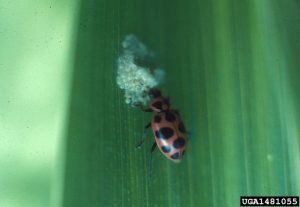
For example, the pink-spotted lady beetle (Coleomegilla maculata) can be an important predator of Colorado potato beetle eggs and larvae. It depends on the availability of aphid prey in crop fields, including crops of alfalfa, brassicas, cucurbits, and corn. It also depends on the availability of pollen from corn or other plants, such as dandelion and yellow rocket. Although this predator does not control Colorado potato beetle on its own, if we knew more about managing C. maculata populations, we might figure out how to make it more effective.
Introducing New Natural Enemies and Establishing a Permanent Population
This process requires extensive research into the biology of the pest, potential natural enemies and their biology, and possible unintended consequences (e.g. negative effects on native species that are not pests or on other natural enemies of the pest). After suitable natural enemies are found, studied and collected, they must undergo quarantine to eliminate any pathogens or parasites on the natural enemy population. Then, the natural enemies are carefully released, timing their arrival with the enemy pest life cycle, in a site where the target pest is abundant, and where they will do well. Although this process is long and complex, when it is successful, the results can be impressive and permanent.
One of many examples of a pest controlled by successful introduction of natural enemies is the alfalfa weevil. The alfalfa weevil is native to Europe, and was first reported in the United States in 1904. It appeared in the eastern United States about 1951, and by the 1970s was a major pest across the country. Larval densities were high enough to require most growers to spray one or more times per year. Several parasitoids were introduced against the weevil. The most successful were two species of parasitoids that attacked the larvae, one that attacked the adult, and a parasitoid and predator that attacked the eggs. In addition, there was a control program to collect natural enemies, rear them in large numbers, and release them. These natural enemies, plus a fungal disease that infects larvae and pupae, has kept weevil densities in the Northeast far below the economic injury levels. The success of this biological control was enhanced by cultural methods, such as timing cuttings to reduce weevil populations and avoid disruption of natural enemies. In addition, introductions of other natural enemies of alfalfa pests and pest-resistant alfalfa varieties minimized insecticide use against alfalfa blotch leafminer and aphids. This also allowed natural enemies of alfalfa weevil to flourish.
Mass Culture and Periodic Release of Natural Enemies
Natural enemies that are repeatedly released require more direct investment and involvement by the farmer. Effectiveness depends on timing and compatible environmental conditions.
Seasonal inoculative release: In some cases, natural enemies can’t overwinter in the Northeast, due to the weather or the lack of suitable hosts or prey. In other cases, such as in greenhouses, natural enemy habitats are shut down at the end of the season or production cycle. So with annual crops, or in seasonal systems, the natural enemy may need to be reintroduced regularly to control pests. In an inoculative release, the natural enemy should reproduce itself throughout the season and eventually reach a balance with the pest population.
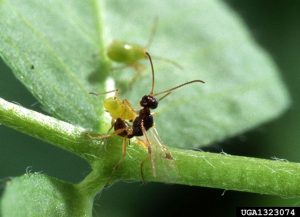
Seasonal inoculative release of insect parasitoids and predators has been a highly successful strategy for biological control in European greenhouses. This strategy was adopted by growers because of pests’ resistance to insecticides, and the rising costs of chemical control. The program was originally built around use of the parasitoid Encarsia formosa against the greenhouse whitefly and the predacious mite Phytoseiulus persimilis against the two-spotted spider mite. Over the years, additional natural enemies have been added to control other pests, such as thrips, leafminers, aphids, caterpillars and other whitefly species. Biological control costs are now much lower in Europe than chemical control costs. Growers learn about programs, new developments and new natural enemies through a network of extension advisers, specialized journals and grower study groups.
Another example of seasonal inoculative release in the field is the use of the parasitic wasp, Pediobius foveolatus against Mexican bean beetles. These parasitoids can not survive Northeast winters. However, they can be reared in the laboratory and released annually, where they multiply, killing their hosts throughout the season. They are reared and released and are also commercially available.
Biological insecticides or inundative release: These two approaches are fundamentally different from all the other approaches to biological control because they do not aim to establish a population of natural enemies that reaches a long-term balance with host or prey population. Instead, they use biological agents, like a pesticide, in quantities that knock down the pest population. Most commercially available formulations of insect pathogens are used in amounts expected to reduce the pest population in one generation, rather than relying on multiplication and spread of the pathogen.
Products based on the bacterium Bacillus thuringiensis (Bt) are the best known examples of biological insecticides. A Bt spray is an insecticide that works by paralyzing the gut of the insect (depending on the strain used, either caterpillars, Colorado or elm leaf beetle larvae, or mosquito or fungus gnat larvae). A protein produced by the bacterium is the active ingredient that paralyzes the gut. In many products, there are no bacterial spores present, just a formulation of the active protein. So, the disease does not spread in the insect population.
Beneficial nematodes are an example of live natural enemies that are inundatively released. These nematodes travel either through the soil or on the soil surface, and actively attack their insect hosts. Once inside, they release symbiotic bacteria, which multiply and kill the host. The nematodes feed on the bacteria and insect tissue, then mate and reproduce. After one to two weeks, young nematodes emerge from the insect cadaver to seek new hosts. Nematodes are highly susceptible to desiccation, exposure to ultraviolet light and temperature extremes. They are most useful against insects living on or in the soil, or in other protected environments (such as tunneling inside plants). Moisture and temperatures of 53 to 86 degrees F are critical to success.
Inundative release of insect and mite natural enemies in the field is still rather expensive, due to the costs of mass rearing, storage and transportation of live organisms. However, research into artificial diets for natural enemies and other aspects of commercial production continues to bring down the cost.
Relationship of Biological Control to Sustainable Agriculture
Native biological control agents and introduced natural enemies, once they are established in the environment, are a self-renewing resource. They multiply themselves by feeding on pests. They cost us only whatever expenses we may incur in encouraging them and enhancing the environment so they may flourish. As long as we sustain them, they will help us to sustain our agricultural system.
Because this form of biological control is seldom dramatic and obvious, its benefits often escape recognition. The array of predators, parasitoids and pathogens that help us keep potential pests under control is a form of biological diversity of major economic importance, and this biological diversity must be preserved.
Sources of More Information
Books about basic principles and practical aspects of biological control:
DeBach, P., 1991, Biological Control by Natural Enemies, 2nd edition, Cambridge University Press, Cambridge, MA.
US Congress, Office of Technology Assessment, 1995, Biologically Based Technologies for Pest Control, OTA-ENV-636, US Government Printing Office, D.C.
Van Driesche, R.G. and T.S. Bellows, Jr., 1996, Biological Control, Chapman and Hall, International Thomson Publishing Co.
For young people:
Jeffords, M.R. and A. S. Hodgins, 1995, “Pests Have Enemies Too: Teaching Young Scientists about Biological Control,” Special Publication 18, Illinois Natural History Survey.
Integrating biological control into pest management systems
Benbrook, C. et al., 1996, Pest Management at the Crossroads, Consumers Union, Yonkers, New York, NY.
Croft, B., 1990, Arthropod Biological Control Agents and Pesticides, John Wiley and Sons, New York, NY.
Pickett, C.H. and R.L. Bugg, 1995, “Enhancing Natural Control of Arthropod Pests through Habitat Management,” AgAccess Publications, Davis, CA.
Van Lenteren. J.C., 1989, “Implementation and commercialization of biological control in west Europe,” pp. 50-70 in International Symposium on Biological Control Implementation, Proceedings and Abstracts, North American Plant Protection Organization Bulletin No. 6.
Extension guides to general biological control
Henn, T. and R. Wienzierl, 1990, “Alternatives in Insect Pest Management: Beneficial Insects and Mites,” Circular 1298, University of Illinois, Forest Park, IL.
Mahr, D.L. and N.M. Ridgway, 1993, “Biological Control of Insects and Mites: An Introduction to Beneficial Natural Enemies and Their Use in Pest Management,” University of Wisconsin, Madison, WI.
Weinzierl, R. and T. Henn, 1989, “Alternatives in Insect Pest Management: Microbial insecticides,” Circular 1295, University of Illinois, Forest Park, IL.
Van Driesche, R.G. and E. Carey, 1987, “Opportunities for Increased Use of Biological Control in Massachusetts,” Research Bulletin 718, Massachusetts Agricultural Experiment Station, Amherst, MA.
This fact sheet was produced by the Northeast Region Sustainable Agriculture Research and Education (SARE) group in cooperation with the University of Maine Cooperative Extension.
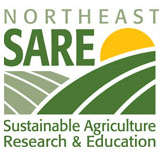
Information in this publication is provided purely for educational purposes. No responsibility is assumed for any problems associated with the use of products or services mentioned. No endorsement of products or companies is intended, nor is criticism of unnamed products or companies implied.
© 2004
Call 800.287.0274 (in Maine), or 207.581.3188, for information on publications and program offerings from University of Maine Cooperative Extension, or visit extension.umaine.edu.
In complying with the letter and spirit of applicable laws and pursuing its own goals of diversity, the University of Maine System does not discriminate on the grounds of race, color, religion, sex, sexual orientation, transgender status, gender, gender identity or expression, ethnicity, national origin, citizenship status, familial status, ancestry, age, disability physical or mental, genetic information, or veterans or military status in employment, education, and all other programs and activities. The University provides reasonable accommodations to qualified individuals with disabilities upon request. The following person has been designated to handle inquiries regarding non-discrimination policies: Director of Institutional Equity and Title IX Services, 5713 Chadbourne Hall, Room 412, University of Maine, Orono, ME 04469-5713, 207.581.1226, TTY 711 (Maine Relay System).


